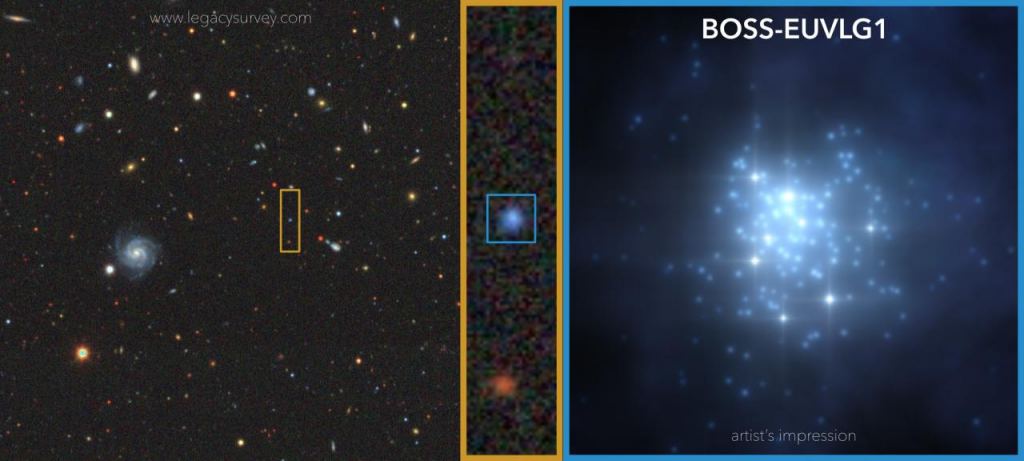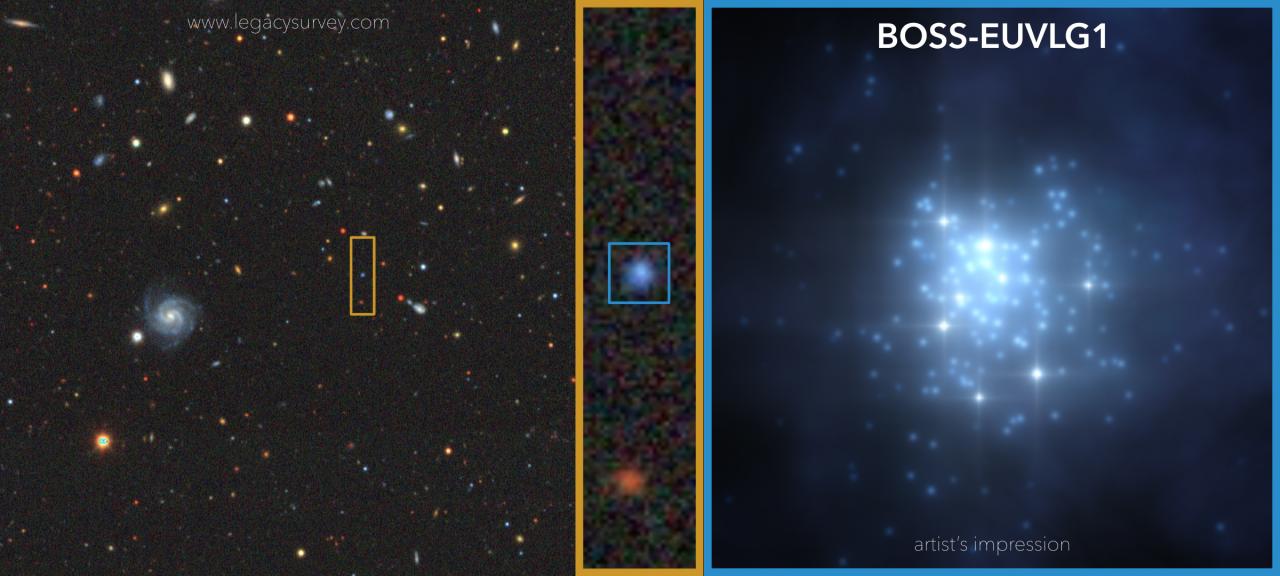Astronomers have found a new type of galaxy that is very old, very distant and very bright in ultraviolet light. This is somewhat an unusual combination, and so when this bright galaxy was first detected, the team of researchers who found it first thought it was a quasar. But detailed study revealed it was actually a galaxy with some other unusual features, which contributes to its brightness: it is busy with star formation, it has almost no dust.
As of now, this galaxy – with the license plate-type name of BOSS-EUVLG1 – appears to be the only one of its kind.
“BOSS-EUVLG1 seems to be dominated by a burst of formation of young, very massive stars, with hardly any dust, and with a very low metallicity,” said Rui Marques Chaves, a researcher at the Center for Astrobiology (CAB) in Madrid, Spain, lead author on an article published in the journal Monthly Notices of the Royal Astronomical Society Letters.
BOSS-EUVLG1 was discovered during analysis of half a million galaxies and quasars in the BOSS project of the Sloan Digital Sky Survey (SDSS). The Baryon Oscillation Spectroscopic Survey (BOSS) was designed to measure the expansion rate of the Universe, and it’s been mapping the spatial distribution of luminous red galaxies (LRGs) and quasars.
The team used a variety of telescopes to study BOSS-EUVLG1: the Gran Telescopio Canarias (GTC), at the Roque de los Muchachos Observatory, (Garafía, La Palma, Canary Islands), and with the ATACAMA Large Millimetre/submillimetre Array (ALMA), in Chile.

BOSS-EUVLG1, has a red-shift of 2.47, which means that we are seeing it when the universe was about 2 thousand million years old, or around 20% of its present age. The red-shift is a measure of the reddening of the light coming from the galaxy, and can be used to find its distance: the further away the galaxy, the greater the value.
The team said that the large values of redshift and luminosity of BOSS-EUVLG1 caused it to be originally classified as a quasar. High luminosity in quasars is due to the activity around the supermassive black holes in their nuclei. However, from the observations made with the OSIRIS and EMIR instruments on the GTC, and with the millimeter wave telescope ALMA, the researchers have shown that it is not a quasar but in fact a galaxy with “extreme, exceptional properties.”
The team’s study revealed that the high luminosity of BOSS-EUVLG1 is due to the large number of young, massive stars in the galaxy. The rate of star formation in this galaxy is very high, around a thousand solar masses per year, around a thousand times higher than that in the Milky Way, although BOSS-EUVLG1 is 30 times smaller.
“This rate of star formation is comparable only to the most luminous infrared galaxies known, but the absence of dust in BOSS-EUVLG1 allows its ultraviolet and visible emission to reach us with hardly any attenuation,” said Ismael Pérez Fournon, an IAC researcher and a co-author of the article.
The team said their research suggests that BOSS-EUVLG1 is an example of the initial phases of the formation of massive galaxies. In spite of its high luminosity and star formation rate, its low metallicity shows that the galaxy has hardly had time to enrich its interstellar medium with dust and newly formed metals.
But the team wrote that eventually the galaxy will evolve towards a dustier phase, and its high luminosity in the UV will last only a few hundred million years, a very short period in the evolution of a galaxy.
“This would explain why other galaxies similar to BOSS-EUVLG1 have not been discovered,” said Claudio Dalla Vecchia, a researcher at the IAC, and another co-author.

